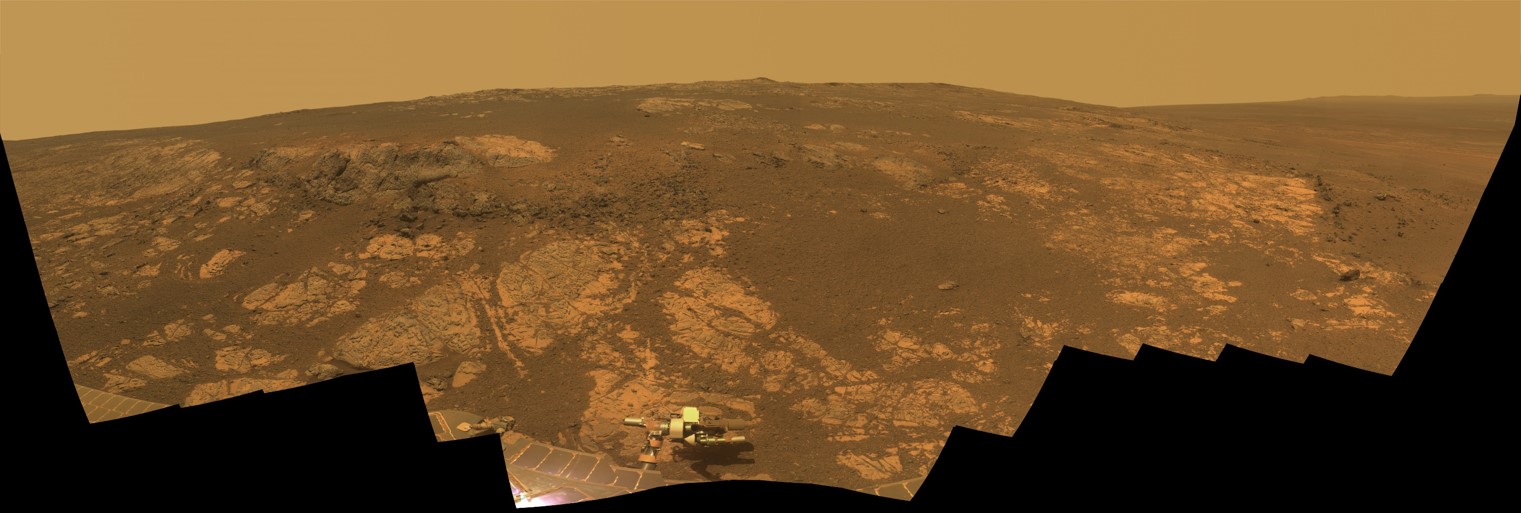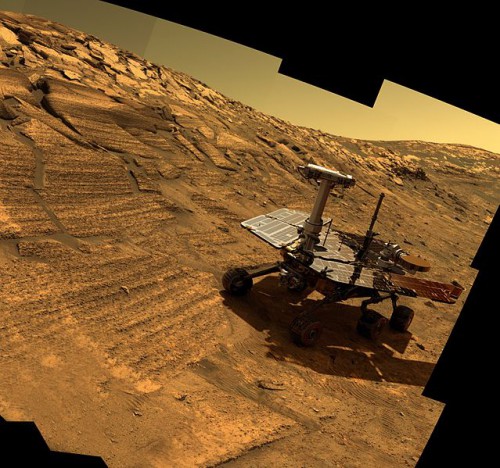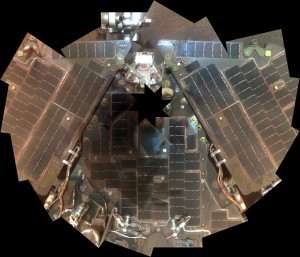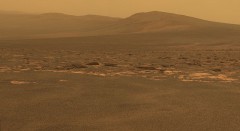
Less than a year after it broke the record for the farthest-driven NASA vehicle on an alien world, the Mars Exploration Rover-B—better known as “Opportunity”—tomorrow celebrates the 10th anniversary of its arrival on the Red Planet … and continues to offer tantalizing answers to its most fundamental mission questions. When it was boosted away from Earth in July 2003, Opportunity was one of two MERs with a mandate to search for and characterize Martian rocks and soils which might hold clues to ancient water activity on the planet. Last May, NASA announced that examinations of the fractured rock “Esperance” yielded tell-tale pointers of a clay-rich specimen whose geological history had been intensely altered by the presence of water. It is another indication that Opportunity, which has operated 37 times longer than intended, is still going strong. However, the engineers and managers who handle MER-B on a daily basis are under no illusions. “We voided the warranty on this thing so many years ago,” said Principal Investigator Steve Squyres in January 2013, “that we just sort of treat every day as a gift.”
And gifted is a metaphor which amply describes Opportunity’s long-lived voyage. It rose from Earth atop a Delta II rocket from Cape Canaveral Air Force Station, Fla., on 7 July 2003, and it reached Mars a little over six months later. Encased in bulky airbags, the 408-pound (185-kg), solar-powered rover bounced its way onto the red-hued Martian surface on 25 January 2004, finally coming to a stop in the most unexpected fashion … in an impact crater. Like its twin, “Spirit,” which also flew from Cape Canaveral on 10 June 2003 and landed on Mars on 4 January 2004, it was intended that Opportunity would endure for at least 90 Earth-days. However, no one could possibly have foreseen the sheer longevity that the small rovers would enjoy. Both Opportunity and Spirit—the latter of which became immobilized in deep sand drifts in 2009 and with which contact was finally lost in 2010—functioned far longer than expected and transformed the public’s perception of Mars in a way that no other previous mission had done.
Physically, Opportunity and Spirit appear puny when compared with their big brother, Curiosity. They share some common characteristics—six wheels and solar power, for example—but are far smaller in terms of size and capability. Standing 5 feet (1.5 meters) high, 7.5 feet (2.3 meters) wide, and 5 feet (1.5 meters) long, they averaged speeds across the Martian terrain of about 0.02 mph (32 meters per hour) and employed a suite of instruments to investigate their surroundings. Of these, the Panoramic Camera (or “Pancam”) has returned electrifyingly beautiful vistas of Mars to us, whilst others have contributed to planetary geologists’ understanding of surface composition and evolution, including the mineralogy of iron-bearing rocks and soils, their elemental constituents, their physical properties, and have slowly uncovered tantalizing clues about the ancient presence of water. A Rock Abrasion Tool (RAT) provided the scope for grinding and brushing surface samples and marked the first attempt to access the interior of a rock on a planet other than our own.

Opportunity touched down in Meridiani Planum, about 15 miles (24 km) east of its planned landing site, and serendipitously rolled into an impact crater, later named “Eagle,” in triple honor of the Apollo 11 crew, the national bird of the United States … and the golfing term which describes sinking a ball two strokes under par. And by landing in the yawning bowl of Eagle, Opportunity lived up to the notion of hitting a “hole in one” … for the interior of the 70-foot-wide (21-meter) crater revealed curious rocky outcrops, whose nature as water- or wind-carried sediments later led to confirmation that Meridiani Planum was once an ancient, salty sea. The historic nature of the landing site was also reflected in its designation of “Challenger Memorial Station,” paying homage to the seven shuttle astronauts who perished in January 1986.
Literally inching its way across the Martian surface, Opportunity’s discoveries came thick and fast in the following weeks, months, and years. In the second half of 2004, it drove into gigantic Endurance crater—which reaches a maximum depth of 66 feet (20 meters)—and found mysterious sand dunes and a bedrock whose chemical composition hinted at ancient flowing water of an “episodic” nature, which periodically flooded the landscape, then dried up. Early in 2005, whilst examining its discarded heat shield, Opportunity found the first meteorite on another planet. Known today as “Heat Shield Rock,” the iron-nickel meteorite marked the first of a handful of Martian meteorites found by Opportunity. Two others were also identified by its sister, Spirit.
Similar circumstances to those which ultimately led to the end of Spirit’s mission almost put paid to the life of Opportunity in early 2006, when it became lodged in a sand dune and necessitated several Earth-based simulations to free several of its wheels. By maneuvering in tiny fits and starts, Opportunity finally dug itself out and headed south, toward its next target craters, the ancient, heavily eroded Erebus and the enormous 0.4-mile-wide (600-meter) behemoth of Victoria. The rover reached Victoria in September 2006, circumnavigated about a quarter of its rim, and sought out possible entrance and exit routes into its interior. A major dust storm, which affected much of the planet, delayed Opportunity’s entrance into Victoria, but it continued to study the giant crater until its final departure in August 2008. Its next objective was to reach the 14-mile-wide (22.5-km) Endeavour crater, whose rim came into the rover’s sights in March 2009. However, it was more than two years—not until August 2011—that the little six-wheeled explorer finally reached the edge, which was touchingly designated “Spirit Point,” after its now-dead sister.

And at Endeavour crater Opportunity currently resides, within a region known as “Cape York,” where it has examined the water-altered Esperance rock and performed radio science observations to better ascertain the probable liquid or solid nature of Mars’ core. Turning to the future, the rover’s next target is the large geological “stack” of Solander Point, another segment of Endeavour crater. This will enable the Opportunity team to reach a 15-degree northerly tilted angle, ahead of its sixth bitter winter on the Red Planet. Such northerly tilting is expected to increase power output from the solar arrays and enable continued operations through the winter.
Last year, Opportunity became the farthest-driven U.S. vehicle ever operated on another world. More than four decades ago, in December 1972, Apollo 17 astronauts Gene Cernan and Jack Schmitt drove a cumulative 22 miles (35 km) across the Moon’s Taurus-Littrow valley in their lunar rover. Until 16 May 2013, they held the official record distance for any NASA wheeled vehicle driven on a world besides our own. That achievement was broken by Opportunity, whose remarkable voyage has now seen it endure 37 times longer than planned and earned it praise from Cernan himself. The veteran astronaut noted that his Apollo 17 record “was made to be broken and I’m excited and proud to be able to pass the torch to Opportunity.”

Glitches have scarred the mission from time to time: it got itself stuck in sand and suffered early problems with the shoulder portion of its robotic arm, but software upgrades in January 2007 expanded its capabilities and empowered it to make its own decisions about image transmission and whether to examine specific rocks. Periodic wind-driven “cleaning events” have removed dust from its solar panels, allowing power output to rise, and at the time of writing Opportunity’s torch shows no sign of dimming. As of this month, it has traveled 22.75 miles (36.6 km), bringing it inexorably closer to breaking the all-time farthest-driven-vehicle record on an extraterrestrial body. That record is presently held by Russia’s Lunokhod 2 rover, which trundled for 23 miles (37 km) across the Moon’s surface between January and June 1973.
Speaking to Bill Harwood on SpaceFlightNow.com, last year, Principal Investigator Steve Squyres expressed astonishment that both vehicles—Opportunity and Spirit—endured so long in such a challenging and unforgiving environment. Aside from the hazards of dirt and dust, Squyres explained, the enormous thermal fluctuations between Martian “daytime” and “nighttime” produced temperature changes on the order of 100 degrees Celsius (212 degrees Fahrenheit). “We’ve been through 3,000-plus thermal cycles, hot-cold, hot-cold, hot-cold,” he told Harwood. “That’s very tough on a spacecraft.”
In time, the stresses imposed on this little rover will take their ultimate toll and, like Spirit, it will fall perpetually silent. Yet the accomplishments of these two rovers—both of which vastly exceeded their design lives and surpassed even the most optimistic expectations—have literally rewritten our textbooks about the history and evolution of Mars. In a very tangible sense, they have “demystified” the Red Planet and have opened it up to the masses. Surely that is their lasting legacy. “We have no idea how much longer this vehicle’s going to last,” Squyres admitted to Harwood. “It could last for years. It could die tomorrow.”
Let us hope that it will be the former.
Want to keep up-to-date with all things space? Be sure to “Like” AmericaSpace on Facebook and follow us on Twitter: @AmericaSpace




What better testament to the genius of mankind in planetary exploration than Spirit, Opportunity and Curiosity. These vehicles and those that follow will provide answers to the ultimate question, “Are we alone?” What an exciting era we live in!
your post implies that Curiosity is solar-powered like the MERs but it is powered by an RTG.